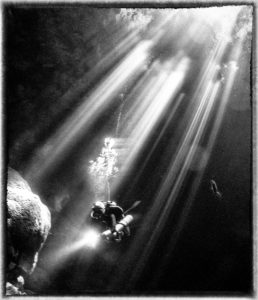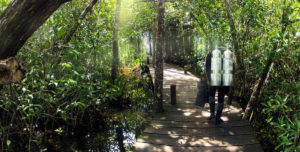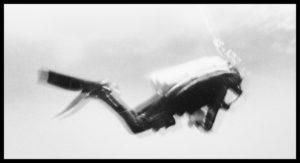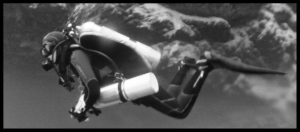The days of deep air diving are long gone, helium is our friend now, not our enemy anymore. I always thought of trimix as a deep diving gas, meaning deep as below and beyond the recreational diving limits.
During an advanced nitrox course I taught not too long ago with local student Andrea we planned and conducted dives in the 80 – 100 foot/24 – 30 meter range when we discovered that Andrea was getting nitrogen narcosis around 90 foot/27 meters of water, fresh water in our case.
I could see her clearly getting affected by the inert gas narcosis watching her communication change, her handwriting to change as well. During de-briefs we came to it that she was affected and did not like it, neither did I.
Realizing that we need a reduction in narcosis made me change the breathing gas (and training program) from advanced nitrox to advanced recreational trimix (IANTD terminology for nitrox with helium) bringing helium into the mix. The word “advanced” meaning we are planning decompression dives and using a stage bottle of ean50 for our decompression to have a better quality of decompression as well as accelerated decompression. V-Planner software was used to plan the dives.
So what is recreational trimix? Recreational trimix combines the advantage of nitrox with an elevated oxygen content in the mix to prolong non-decompression times and shorten decompression obligations with the adage of helium to reduce and adjust the narcosis level at any given depth to the users liking, in our case (and IANTD standards) the narcosis depth was adjusted to 80 feet/24 meters.
Subsequent dives where planned and conducted using 30/15 and 28/15 trimix mixtures allowing us to plan and conduct sinkhole and cave dives (Andrea is a cave diver as well as sidemount cave diver) to 120 – 130 feet/36 – 40 meters without the feel of any narcosis as the narcosis level of the breathing gas was adjusted to 80 feet/24 meters, a depth Andrea did not feel any signs of narcosis.
As we were diving within recreational depth limits the implementation of helium greatly attributed to the save and nitrogen narcosis free dives we both enjoyed so much. Trimix is not necessarily a deep diving gas. Yes, diving close to the recreational diving depth limit is somewhat deep but not what most trimix divers would consider deep. There are divers however that might feel the onset of inert gas narcosis at a much shallower depth, well before the recreational depth limits usually associated with inert gas or nitrogen narcosis.
Memorable in particular was our last training dive at the end of her training program conducted in “the Pit”. Awesome diving with a great student. Congratulations Andrea for a job well done.

Matt



